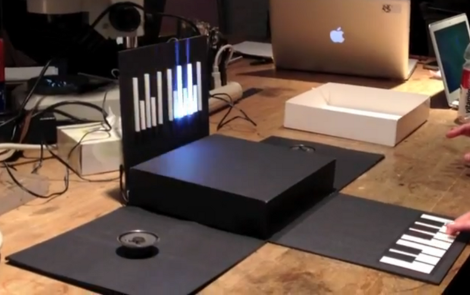
We love the look of this papercraft piano which [Catarina] built along with some friends at NYC Resistor, a hackerspace in the big apple. It starts off as a cubic black box with a white top. But just lift that top as [Catarina] does in the video after the break and three of the sides fall flat to reveal a pair of speakers and the single-octave keyboard.
The key’s don’t move when you press them. Instead, she decided to use the CapSense Arduino library to implement touch sensitive keys. Each key is made up of a plane of copper foil tape, with a strip of tape running back to the center of the box where it is interfaced with an Arduino Mega hidden there. The Tone library produces the waveforms which are played by the speakers, and a set of LEDs on the upright side of the box illuminate the keyboard diagram as you press each key. You can see that there are short white bars on that display which correspond to the black keys on the keyboard.
If you take a look at the code, you’ll see the libraries really make the code for the project simple.
[youtube=http://www.youtube.com/watch?v=FFA44-gTNIM&w=470]
[Thanks Erik]















after what break?
I guess the old adage if you have nothing nice to say, say nothing at all finally sunk in :) not a very complicated project but it is kinda neat i think the speakers should have covers that look like half of a sandwich box and it would polish the look a bit
Next lesson: practice what you preach.
It hurts me to see an entire Arduino basically go to waste in that box. Dammit woman, y u no do this with CMOS logic?
I think it’s interesting that she used the hardware timers rather than doing some more manual synthesis. If it’s just the PWM outputs that limits you to square waves only with no enveloping. I get that simplicity was a goal here but this seems like a very expensive use of an Arduino Mega when a lot more could be done with it.
I accidentally reported this comment when scrolling up the page. Shouldn’t a report feature have a confirm dialogue?
CMOS logic is okay if you don’t want to do a tuned LC circuit and superhetrodyne comparator with op-amps.
Kinda cool I think…who cares if she underutilized the Arduino…seriously you guys never seem to miss an opportunity to bitch about the use of one.
Altho PWM is output as a square wave at very high frequency, the lower-frequency result it produces is a pretty bang-on accurate reconstruction of a sine wave, or whatever wave you want. Put a simple low-pass filter in, and you can’t tell the difference. PWM DACs are old news, they do a fine job. All that matters is the frequency they run at, which determines the effective sampling rate / bit accuracy. 1-bit CD players using PWM are common, and available in hi-fi.
What I’d like to see, is some of those almost-flat speakers! Or perhaps even a few piezos. A keyboard that rolls up like a sheet of paper, with a little box for the works, would look great!
On the other issue, an Arduino is easier and cheaper, to get the result. And allows expansion like using samples of different instruments. Lots of things CAN be done in discrete components, but if the alternative is better, why bother?
Outputs a sinewave at low frequency?
What?
How? It’s supposed to be a digital signal! Look at the code, it’s not using the PWM outputs to create a class D situation, the timer hardware is being used to directly create the frequency desired, and if there is any low pass filtering it’ll affect higher frequencies a lot more than lower frequencies.
The other useful thing, is the Capsense built-in. Using a separate chip (not sure what Capsense make in that line), or god-forbid doing it yourself, would add extra time and work on a problem that’s already been solved. It’s a great idea, and lets people with less advanced knowledge than others, ACTUALLY DO SOMETHING! Which is worth a thousand comments.
None of this diminishes a great build, by the way. Very elegant design and neat. Love the LED readout.
Think this is a great idea/project. Just want to
convert it into a theremin/piano!